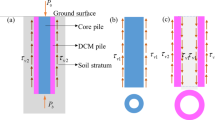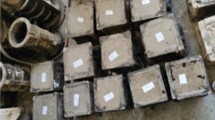Abstract
There are several strength prediction relations developed for plain cement paste, mortar and concrete. In concrete where air voids contribute significantly to volume of voids (like aerated and foam concrete), more general expressions including the volume of air voids is to be developed as the better alternative. The objective of this paper is to propose prediction relations for the compressive strength of foam concrete by extending two of the well-known relations available for cement paste, mortar and normal concrete, viz., Balshin’s strength-porosity model and Power’s gel-space ratio equation. For this, theoretical equations were derived for porosity and gel-space ratio relating it to the density, proportion of ingredients in the mix and material characteristics like specific gravity. Foam concrete with fly ash showed lesser dependency on pore parameters than cement-sand mixes. As both the prediction relations developed in this study consider the effect of composition on the strength, it can serve as a simple tool for predicting the strength of foam concrete. But strength-porosity model stands out compared to gel-space model as it correlates well with the measured strength and also because of its ease in application since it employs the composition of constituents and easily measurable parameters.




Similar content being viewed by others
References
Tam CT, Lim TY, Lee SL (1987) Relationship between strength and volumetric composition of moist-cured cellular concrete. Mag Concr Res 39:12–18
Neville AM (1995) Properties of concrete, 4th edn. Longman, London
RÖßler M, Odler I (1985) Investigations on the relationship between porosity, structure and strength of hydrated Portland cement pastes. Cem Concr Res 15:320–330
Nielsen LF (1993) Strength development in hardened cement paste: examination some empirical equations. Mater Struct 26:255–260
Hoff GC (1972) Porosity-strength considerations for cellular concrete. Cem Concr Res 2:91–100
Kearsley EP, Wainwright PJ (2002) The effect of porosity on the strength of foamed concrete. Cem Concr Res 32:233–239
Narayanan N, Ramamurthy K (2000) Prediction relations based on gel-pore parameters for the compressive strength of Aerated Concrete. Concr Sci Eng 1(2):206–212
Durack JM, Weiqing L (1998) The properties of foamed air cured fly ash based concrete for masonry production. In: Proceedings of 5th Australian Masonry Conference, Gladstone, Queensland, Australia, June 1998, pp 129–138
Hansen TC (1986) Physical aspects of hydration of Portland cement. Mater Struct 19:423–429
Watson KL (1980) Autoclaved aerated concrete from slate waste Part 2: Some property/porosity relationship. Int J Lightweight Concr 2(3):121–123
Bureau of Indian Standards. IS 12269. Specifications for 53 grade ordinary Portland cement. Bureau of Indian Standards, New Delhi, 1987
American Society of Testing and Materials. ASTM C 618. Standard specification for fly ash and raw or calcined natural pozzolana for use as a mineral admixture in Portland cement concrete. Am Soc Test Mater, Philadelphia, 1989
Nambiar EKK, Ramamurthy K (2006a) Fresh state characteristics of foam concrete. ASCE J Mater Civil Eng (accepted for publication)
American Society for Testing and Materials. ASTM E 122. Standard recommended practice for choice of sample size to estimate the average quality of a lot or process. Am Soc Test Mater, Philadelphia, 1972
American Society for testing and materials. ASTM C 1202. Standard test method for electrical indication of concrete’s ability to resist chloride ion penetration. Am Soc Test Mater, Philadelphia, 1997
Taylor HFW (1997) Cement chemistry, 2nd edn. Thomas Telford, London
Nambiar EKK, Ramamurthy K (2007) Air-void characterization of foam concrete. Cem Concr Res 37:221–230
Nambiar EKK, Ramamurthy K (2006b) Influence of filler type on the properties of foam concrete. Cem Concr Compos 28:475–480
Author information
Authors and Affiliations
Corresponding author
Rights and permissions
About this article
Cite this article
Nambiar, E.K.K., Ramamurthy, K. Models for strength prediction of foam concrete. Mater Struct 41, 247–254 (2008). https://doi.org/10.1617/s11527-007-9234-0
Received:
Accepted:
Published:
Issue Date:
DOI: https://doi.org/10.1617/s11527-007-9234-0




